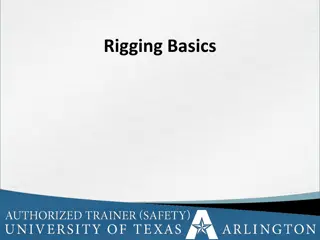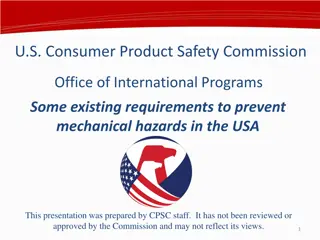Oil and Gas Industry Hazards and Control Measures
Learn to mitigate fire, explosion, exposure, physical hazards, falls, transportation risks, and natural hazards in the oil and gas sector. Effective control measures reduce risks and ensure worker safety. Explore key safety protocols.
2 views • 13 slides
Ensuring Mine Road Safety: Key Controls and Hazards
National Mine Safety Week 2023 focuses on safe road conditions in mining areas. The environment poses risks like overhanging trees and weather conditions, while road-related hazards include heavy loads and road design issues. This article highlights driving hazards, road design and maintenance hazar
0 views • 9 slides
Workplace Hazards and Safety Measures Awareness
Learn about common workplace hazards such as falls, chemical exposure, fire, electrical hazards, and repetitive motion injuries. Understand the risks associated with these hazards and the importance of prioritizing safety in the workplace to prevent accidents and injuries. Stay informed and take pro
1 views • 33 slides
Biological Hazards in the Hospital Community
Healthcare workers face various occupational hazards, including biological risks, in hospital settings. This article by Ephraim E. Ibadin explores the definition, types, risk factors, sources, prevention, and control of biological hazards in hospitals, emphasizing the importance of protecting worker
0 views • 30 slides
Environmental Hazards Faced by Veterans and Agent Orange Exposure Locations
Veterans may have been exposed to a variety of environmental hazards during their military service, including Agent Orange-related diseases, Gulf War illnesses, radiation-related diseases, traumatic brain injury, and more. Agent Orange exposure locations include Vietnam, C-123 airplanes, Blue Water
1 views • 40 slides
Chemical Agents Awareness Training Overview
This training module covers standardized awareness and authorized training on chemical agents, including toxic industrial chemicals, riot control agents, and chemical warfare agents. Participants will learn about the physiological signs/symptoms, advantages/disadvantages of using chemical agents for
1 views • 20 slides
Enhancing Chemical Formula Writing Skills for Students
This action research focuses on improving students' ability to write and name chemical formulas. The study addresses challenges in understanding and applying chemical concepts in a general chemistry course. Strategies include utilizing worksheets, group collaboration, and mobile applications to enha
2 views • 13 slides
Essential Crane Safety Training and Hazards Awareness
This training covers various hazards associated with crane use, OSHA standards, inspection guidelines, and common issues like electrical hazards, overloading, and poor weight distribution. The content emphasizes the importance of maintaining crane safety to prevent accidents, injuries, and damage to
0 views • 30 slides
Understanding Chemical Kinetics: Rates of Reactions and Factors Influencing Them
Chemical kinetics delves into the speed of chemical reactions and the factors that influence reaction rates. This field explores how collisions between atoms, ions, or molecules drive chemical reactions, as well as the role of catalysts, reactant concentration, temperature, and surface area. By unde
0 views • 32 slides
Rigging Safety and Hazards Awareness
Learn about common rigging hazards, including fall hazards, struck-by and crushing hazards, electrical hazards, and rigging failure examples. Understand the importance of proper training, equipment inspection, and safety protocols to prevent accidents and injuries in rigging operations.
0 views • 34 slides
Enhancing Synergies for Resilient Tomorrow: Chemical Waste Management Project Overview
Enhancing Synergies for a Resilient Tomorrow outlines a project aimed at strengthening the Federated States of Micronesia's capacity in chemical management. The project focuses on monitoring and evaluating chemical use, enhancing legislative frameworks, and establishing a central database for chemic
1 views • 12 slides
Preventing Mechanical Hazards in Consumer Products: U.S. Regulations
The U.S. Consumer Product Safety Commission (CPSC) enforces various requirements to prevent mechanical hazards in consumer products. These regulations cover toys, children's clothing, infant products, and more. Standards such as ASTM F963 outline specific safety measures for small parts, strangulati
1 views • 13 slides
The Significance of Environmental Hygiene in Public Health
Environment and environmental hygiene play pivotal roles in public health by encompassing factors that influence human health and well-being. Environmental hygiene focuses on controlling adverse conditions in the physical environment to maintain and enhance health. It aims at preventing and managing
0 views • 20 slides
Importance of Workplace Inspections and Hazard Identification
Workplace inspections are critical processes to identify and mitigate hazards in a work environment. These inspections help ensure the safety of employees by addressing potential risks such as biological, chemical, physical, safety, ergonomic, and psychosocial hazards. Regular inspections allow for
2 views • 12 slides
Understanding Natural Hazards and Their Impacts
Natural hazards, including tectonic and weather-related events, pose significant risks to humans and property. The effects and responses to tectonic hazards vary based on wealth levels in different regions. Earthquakes and volcanic eruptions result from physical processes, with patterns observed alo
1 views • 15 slides
Understanding Natural Hazards and Their Impact on Society
Explore the world of natural hazards, their causes, examples, and the transition to natural disasters. Learn how human actions can influence the frequency and severity of hazards. Discover the interconnectedness between nature and society in dealing with these events.
0 views • 10 slides
Understanding Health Hazards in Chemical Production
Organic chemistry plays a vital role in producing various products, but it also poses serious health and environmental risks. Issues such as acute and chronic toxicity, carcinogens, mutagens, and teratogens are prevalent in chemical production. Awareness of these hazards has led to strict regulation
1 views • 30 slides
Understanding Risk Assessments and Hazards in Everyday Life
Risk assessments involve evaluating potential hazards and assessing the likelihood and consequences of those hazards. In the context of crossing the road, different scenarios demonstrate varying levels of risk based on factors such as vehicle speed, pedestrian behavior, and road conditions. By under
0 views • 23 slides
Overview of Chemical Reactor Design and Operation
Chemical reactor design involves studying the rates and mechanisms of chemical reactions, as well as the design of reactors for these reactions on a commercial scale. This field combines principles from thermodynamics, chemical kinetics, fluid mechanics, mass transfer, heat transfer, and economics t
0 views • 12 slides
Ensuring Office Safety: Hazards, Prevention, and Training
Today's offices are prone to various hazards that can lead to injuries and health issues. This presentation covers common office accidents, safety considerations, and preventive measures such as ergonomic practices, fall prevention, and emergency action plans. It emphasizes the importance of control
0 views • 44 slides
Occupational Hazards in Healthcare and Engineering Equipment Development for COVID-19 Protection
Corona Virus, or COVID-19, poses significant health hazards to individuals, especially healthcare workers. This article explores the spread of the virus, types of health hazards, and solutions for prevention. It emphasizes the critical need for developing engineering equipment to support and protect
0 views • 12 slides
Understanding Environmental Hazards and Management
Exploring major hazards management, geology perspectives, ecological concepts, natural environmental hazards, classes of natural hazards, and introduction to environmental hazards management. The content covers ecological levels, abiotic factors, biomes, environmental degradation, and more.
0 views • 10 slides
Understanding Workplace Safety Hazards: Physical, Chemical, and Biological Risks
Explore the three main types of workplace safety hazards - physical, chemical, and biological - with a focus on identifying potential risks and ensuring a safe work environment. Learn about common hazards such as repetitive motion, chemical exposure, and handling biological materials, essential for
0 views • 97 slides
Understanding Natural Hazards and Plate Boundaries
Learn about natural hazards such as volcanic eruptions, earthquakes, and storms that pose risks to human populations. Discover how factors like urbanization, poverty, climate change, and farming increase vulnerabilities to these hazards. Explore plate boundaries, crust types, and examples of geologi
0 views • 21 slides
Understanding Chemical Changes and Reactions
Explore the concepts of chemical and physical changes, including balancing chemical equations, physical properties, and examples of chemical reactions. Learn to distinguish between physical and chemical changes through visual aids and learning checks.
0 views • 24 slides
Preventing Slips, Trips, and Falls: Hazard Awareness and Safety Guidelines
Be aware of hazards both indoors and outdoors to prevent slips, trips, and falls. Keep work areas clear, return equipment to designated places, and report hazards to managers promptly. Look ahead for hazards, avoid distractions while walking, and conduct dynamic risk assessments to ensure safety. Re
0 views • 4 slides
Understanding Environmental Health and Hazards
The field of environmental health focuses on preventing human injury and illness by evaluating and limiting exposure to hazardous agents in the air, water, and soil. Various environmental hazards such as water and air pollution, climate change, and occupational hazards pose significant risks to huma
0 views • 10 slides
Understanding Processor Hazards and Pipeline Stalls
Explore processor hazards like load-use and data hazards, along with strategies to avoid stalls in the pipeline. Discover how to detect and handle hazards efficiently for optimal performance in computer architecture. Learn about forwarding conditions, datapath design, and the impact of hazards on in
0 views • 30 slides
Environmental Aspects of Pharmaceutical Industry in India
The pharmaceutical industry in India poses various environmental hazards through manufacturing processes, handling of hazardous chemicals, waste disposal, and natural calamities. Hazardous waste types, sources of hazards, and examples of chemical waste highlight the importance of implementing effect
0 views • 31 slides
Combining Natural Hazards with Societal Issues: Unit 1 Hazard Map Template
Delve into Unit 1 of the Hazard Map Template, identifying and locating regions susceptible to hazards by choosing top hazards in the mapping area. Create hazard maps, combine shapes, and include a key and sources for a comprehensive view of potential hazards and vulnerabilities.
0 views • 13 slides
Understanding Pipeline Hazards in Computer Architecture
Pipeline hazards in computer architecture are classified into three categories: structural, data, and control hazards. Structural hazards occur due to conflicts in hardware resources, data hazards stem from dependencies between instructions, and control hazards arise from branching instructions. The
0 views • 42 slides
Understanding Physical and Chemical Changes in Science Class
Explore the concepts of physical changes and chemical reactions in this interactive science lesson. Students will differentiate between the two types of changes, identify evidence for each, categorize examples, and discuss key concepts with their peers at the table. Through videos and discussions, t
0 views • 21 slides
ASU EHS & FSE Chemical Approval Process Guidelines
Detailed guidelines and forms for the chemical approval process at ASU, including links to important resources, forms for new chemical purchases and transfers, responsibilities for lab managers, and procedures for chemical transfers. The process involves completing forms such as the Prior Approval A
0 views • 5 slides
Understanding Chemical Reactions in Daily Life
Understanding chemistry, particularly chemical reactions, is crucial for our daily lives. Chemical reactions involve the transformation of substances into different ones, described by reactants and products in equations. By learning about chemical equations, word equations, formula equations, and th
0 views • 15 slides
Workshop on Artificial Intelligence in Natural Hazards Engineering
This workshop focuses on exploring the integration of artificial intelligence and machine learning with natural hazards engineering, discussing data representations, classification models, combining ML with hazards simulations, and addressing classification problems in the field. Participants engage
0 views • 5 slides
Map Your Hazards Module Overview: Identifying Natural Hazards and Social Vulnerabilities
Explore the Map Your Hazards Module, a comprehensive program designed to help communities identify natural hazards, assess social vulnerabilities, and enhance preparedness. Through tasks like local risk mapping and social surveys, learn to mitigate risks and support communities in facing potential d
0 views • 17 slides
Recognizing Laboratory Hazards: Physical Hazards and Corrosive Chemicals
Laboratory hazards, particularly physical hazards and corrosive chemicals, pose risks to individuals working in laboratory settings. Corrosives, such as acids, bases, oxidizing agents, and gases, can cause significant harm to eyes and skin. Proper precautions and handling procedures are crucial to m
0 views • 16 slides
Understanding Ionic Bonding and Lattice Energy in Chemistry
Chemical bonds play a crucial role in holding atoms together in molecules. This course explores the concept of chemical bonding, focusing on ionic bonds and lattice energy. Topics covered include the different types of chemical bonds, such as electrovalent and coordinate bonds, as well as the models
0 views • 22 slides
Data Hazards in Pipelined Processors: Understanding and Mitigation
Explore the concept of data hazards in pipelined processors, focusing on read-after-write (RAW) hazards and their impact on pipeline performance. Learn strategies to mitigate data hazards, such as using a scoreboard to track instructions and stall the Fetch stage when necessary. Discover how adjusti
0 views • 23 slides
Best Practices for Chemical Hygiene and Safety in Laboratories
Responsibilities of the Chemical Hygiene Officer (CHO) include implementing the Chemical Hygiene Plan (CHP), monitoring the chemical life cycle, arranging staff training, conducting safety inspections, assisting staff, and maintaining records. Principals and Science Department Heads support staff in
0 views • 18 slides







































